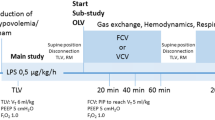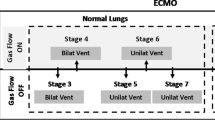Abstract
Endotoxinaemia (E. coli endotoxin, 0.111.B4) and pulmonary hypertension were evoked in 20 swine, randomly assigned to receive either zero-balanced venovenous haemofiltration (HF) with an ultrafiltration and replacement rate of 600 ml/h (HF group,n=10) or to undergo an uninfluenced spontaneous course (E group,n=10) during a constant infusion of endotoxin until the end of the experiment. Endotoxin-induced pulmonary dysfunction was assessed on the basis of extravascular lung water (EVLW) using a thermo-dye technique via a fiberoptic intra-aortic probe, gas exchange and lung mechanics, the latter derived by a pressure-volume loop (P/V loop) of the respiratory system (super syringe, flow 30 ml/s, tidal volume 600 ml). A comparable increase in alveolo-arterial oxygen difference and a constant EVLW was observed in both groups. The progessive deterioration of hysteresis area and compliance parameters by endotoxinaemia was significantly blunted by HF. Independent of an impact on pulmonary oedema zero-balanced HF modifies endotoxin induced lung injury, probably by the convectice transport of mediator substances.
Similar content being viewed by others
References
Mauritz W, Sporn P, Schindler I, Zadrobilek E, Roth E, Appel W (1986) Akutes Nierenversagen bei abdomineller Sepsis—Vergleich von Hämodialyse and kontinuierlicher ateriovenöser Hämofiltration. Anaesth Intensivther Notfallmed 21:212–217
Simpson K, Allison M (1988) Acute renal failure — continuous ultrafiltration and bicarbonate haemodialysis (CUPID). Intensive Care World 5:83–84
Wardle N (1982) Acute renal failure in the 1980's: the importance of septic shock and of endotoxinaemia. Nephron 30:193–200
Cameron JS (1986) Acute renal failure in the intensive care unit today. Intensive Care Med 12:64–70
Schetz M, Lauwers PM, Ferdinande P (1989) Extracorporeal treatment of acute renal failure in the intensive care unit: a critical view. Intensive Care Med 15:349–357
Wendon J, Smithies M, Sheppard M, Bullen K, Tinker J, Bihari D (1989) Continuous high volume veno-venous haemofiltration in acute renal failure. Intensive Care Med 15:358–363
Gotloib L, Barzilay E, Shustak A, Wais Z, Jaichenko J, Lev A (1986) Hemofiltration in septic ARDS. The artifical kidney as an artificial endocrine lung. Resuscitation 13:123–132
Gotloib L, Barzilay E, Shustak A, Wais Z, Lev A (1985) Hemofiltration in severe septic adult respiratory distress syndrome associated with Varicella. Intensive Care Med 11:319–322
Stein B, Pfenninger E, Grünert A, Schmitz JE, Hudde M (1990) Influence of continuous haemofiltration on haemodynamics and central blood volume in experimental endotoxic shock. Intensive Care Med 16:494–499
Staubach KH, Rau HG, Kooistra A, Schardey HM, Hohlbach G, Schildberg FW (1988) Can hemofiltration increase survival time in acute endotoxinemia — a porcine shock model. Abstract: Second Vienna Shock Forum, Mey 11–14, 1988, Vienna, Austria, p 69
Gomez A, Wang R, Unruh H, Light RB, Bose D, Chau T, Correa E, Mink S (1990) Hemofiltration reveries left ventricular dysfunction during sepsis in dogs. Anesthesiology 73:671–685
Kühl PG, Bolds JM, Loyd J, Snapper JR, Fitzgerald GA (1988) Thromboxane receptor-mediated bronchial and hemodynamic responses in ovine endotoxinemia. Am J Physiol 254:R 310–319
Brigham KL, Meyrick B (1986) Endotorin and lung injury. Am Rev Respir Dis 133:913–927
Ball HA, Cook JA, Wise WC, Halushka PV (1986) Role of thromboxane, prostaglandins and leukotrienes in endotoxic and septic shock. Intensive Care Med 12:116–126
Snapper JR, Coggeshall JW, Serafin WE, Phillips MA, Lefferts PL, Christman BW (1987) Role of leukotrienes in an animal model of the adult respiratory distress syndrome. In: Samuelsson B, Paoletti R, Ramwell PW (eds) Advances in prostaglandin, thromboxane, and leukotriene research. Raven Press, New York, pp 1043–1046
Gross D, Dahan JB, Landau EH, Krausz MM (1990) Effect of leukotriene inhibitor LY-171883 on the pulmonary response to Escherichia coli endotoxinemia. Crit Care Med 18:190–197
Wickerts CJ, Jakobsson J, Frostell C, Hedenstierna G (1990) Measurement of extravascular lung water by thermal-dye dilution technique: mechanisms of cardiac output dependence. Intensive Care Med 16:115–120
Stein B, Maucher H, Wiedeck H, Born B, Ahnefeld FW (1989) Die Steuerung der Ultrafiltrationsrate als Hauptkomponente eines neuen Bilanzierungssystemes während kontinulerlicher Hämofiltration. Anaesthesist 38:536–538
Mankikian B, Lemaire F, Benito S, Brun-Buisson C, Harf A, Maillot JP, Becker J (1983) A new device for measurement of pulmonary pressure volume curves in patients on mechanical ventilation. Crit Care Med 11:897–901
Gattinoni L, Mascheroni D, Basilico E, Foti G, Pesenti A, Avalli L (1987) Volume/pressure curve of total respiratory system in paralysed patients: artefacts and correction factors. Intensive Care Med 13:19–25
Dall'Ava-Santucci J, Armaganidis A, Brunet F, Dhainaut JF, Chelucci GL, Monsallier JF, Lockhardt A (1988) Causes of error of respiratory pressure-volume curves in paralyzed subjects. J Appl Physiol 64:42–49
Beutler B, Cerami A (1987) Cachectin: More than a tumor necrosis factor. N Engl J Med 316:379–385
Oettinger W, Beger HG (1989) How spacific is eicosanoid release in the surgical sepsis syndrome. Theor Surg 3:171–180
Sweet SJ, Glenney CU, Fitzgibbons JP, Friedmann P, Teres D (1981) Synergistic effect of acute renal failure and respiratory failure in the surgical intensive care unit. Am J Surg 141:492–495
Kramer P, Wigger W, Rieger J et al: Arterious hemofiltration: a new simple method for treatment of overhydrated patients resistant to diuretics. Klin Wochenschr 1977; 55:1121
Wilkowski A, Goeckenjan G (1988) Auswirkungen des Flüssigkeitsentzuges auf pulmonale Verlaufsparameter und Prognose des akuten Lungenversagens. Intensivmedizin 25:10–16
Deby-Dupont G, Braun M, Lamy M, Deby C, Pincemail J, Faymonville ME, Damas P, Bodson L, Lecart MP, Goutier R (1987) Thromboxane and prostacyclin release in adult respiratory distress syndrome. Intensive Care Med 13:167–174
Antonelli M, Bufi M, De Blasi RA, Crimi G, Conti G, Mattia C, Vivino G, Lenti L, Lombardi D, Dotta A, Pontieri G, Gasparetto (1989) Detection of leukotrienes B4, C4 and of their isomers in arterial, mixed venous blood and bronchoalveolar lavage fluid from ARDS patients. Intensive Care Med 15:296–301
Lava JS, Rice CL, Levine HA, Moss GS (1982) Extravascular lung water as a function of the magnitude of pulmonary artery pressure in the septic pig. J Surg Res 32:440–447
Olson NC, Brown TT, Anderson DL (1985) Dexamethasone and indomethacin modify endotoxin-induced respiratory failure in pigs. J Appl Physiol 58:274–284
Magilligan DJ (1985) Effects of Ultrafiltration on Lung Water. In: Sieberth HG, Mann H (eds) Continuous arteriovenous hemofiltration (CAVH). Rarger, Basel, pp 80–95
Coraim FJ, Coraim HP, Ebermann R, Stellwag FM (1986) Acute respiratory failure after cardiac surgery: clinical experience with the application of continuous hemofiltration. Crit Care Med 14:714–718
McCaffree DR, Gray BA, Pennock BE, Coalson J, Bridges C, Taylor FB, Rogers RM (1981) Role of pulmonary edema in the acute pulmonary response to sepsis. J Appl Physiol 50:1198–1205
Esbenshade AM, Newman JH, Lams PM, Jolles H, Brigham KL (1982) Respiratory failure after endotoxin infusion in sheep: lung mechanics and lung fluid balance. J Appl Physiol 53:967–976
Nielson D, Olsen DB (1978) The Role of alveolar recruitment and de-recruitment in pressure-volume hysteresis in lungs. Respir Physiol 32:63–77
Andreasson S, Bylock A, Smith L, Risberg B (1986) Extravascular lung water measurement in septic sheep. J Surg Res 40:95–104
Golper TA, Jenkins R, Wright M, Klein JB (1990) Tumor necrosis factor (TNF) and hemofiltration membranes. (Abstract) Intensivbehandlung 15:119
Sznajder JI, Zucker AR, Wood LDH, Long GR (1986) The effects of plasmapheresis and hemofiltration on canine acid aspiration pulmonary edema. Am Rev Respir Dis 134:222–228
Author information
Authors and Affiliations
Rights and permissions
About this article
Cite this article
Stein, B., Pfenninger, E., Grünert, A. et al. The consequences of continuous haemofiltration on lung mechanics and extravascular lung water in a porcine endotoxic shock model. Intensive Care Med 17, 293–298 (1991). https://doi.org/10.1007/BF01713941
Received:
Accepted:
Issue Date:
DOI: https://doi.org/10.1007/BF01713941




